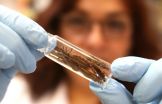(Press-News.org) Scientists at Disney Research and the University of Washington (UW) have shown that a network of energy-harvesting sensor nodes equipped with onboard cameras can automatically determine each camera's pose and location using optical cues.
This capability could help to enable networks of hundreds or thousands of sensors that could operate without batteries or external power and require minimal maintenance. Such networks could be part of the Internet of Things (IoT) in which objects can communicate and share information to create smart environments.
Previous work at UW has produced battery-free RFID tags called WISPs with enhanced capabilities such as onboard computation, sensing, and image capture capabilities. WISPs operate at such low power that they can scavenge the energy needed for operation from radio waves. The new work shows that these WISPs with onboard cameras, or WISPCams, can use optical cues to figure out where they are located and the direction in which they are pointed. The ability of each node to determine its own location makes deployment of autonomous sensor nodes easier and the sensor data they produce more meaningful.
"Once the battery free cameras know their own positions it is possible to query the network of WISPCams for high level information such as all images looking west or sensor data from all nodes in a particular area," said Alanson P. Sample, a research scientist with Disney Research who previously was a post-doctoral researcher on the UW team that developed the WISP platform and the WISPCam.
Future iterations of this RFID-based sensing technology has the potential to enable low cost and maintenance-free IoT applications by eliminating the need for external wiring or regular battery replacement. Networks of hundreds or thousands of these sensors could be used to monitor the condition of infrastructure such as bridges, industrial equipment monitoring, and home security monitoring.
Sample and his collaborators - Joshua Smith, associate professor of computer science and engineering, at the University of Washington and his students Saman Naderiparizi, Yi Zhao and James Youngquist - presented their findings at Ubicomp 2015, the International Joint Conference on Pervasive and Ubiquitous Computing, in Osaka, Japan.
In this study, the researchers addressed two related networking issues - how to design sensors that can determine their position and pose, how to reduce the amount of data that needs to be transmitted over the network and how to better manage the small amount of power that their RF antennas capture.
The researchers used an image processing technique called Perspective-n-Point (PnP) to determine location and pose. This involves capturing an image of an object and then comparing it with a second image in which four LEDs in a known configuration illuminate the object. Using this technique, the cameras were able to estimate their position to within a few centimeters. In their experimental setup, the researchers used four WISPCams and a separate WISP with LEDs, but Sample noted that the LEDs could be incorporated into each WISPCam.
Rather than send all of these images to a central computer- a laborious chore in networks that might include hundreds or thousands of camera sensors and one that would place great demands on the low-power devices - the researchers showed that innovative circuitry and firmware enabled the initial processing necessary for localization to be performed onboard each sensor.
INFORMATION:
This work was supported by the Intel Science and Technology Center for Pervasive Computing, a gift from Disney Corp., a Google Faculty Research Award and a National Science Foundation grant (CNS-1305072).
For more information, including a video, please visit the project web site http://www.disneyresearch.com/publication/Self-Localizing-Battery/ .
About Disney Research
Disney Research is a network of research laboratories supporting The Walt Disney Company. Its purpose is to pursue scientific and technological innovation to advance the company's broad media and entertainment efforts. Vice Presidents Jessica Hodgins and Markus Gross manage Disney Research facilities in Los Angeles, Pittsburgh, Zürich, and Boston and work closely with the Pixar and ILM research groups in the San Francisco Bay Area. Research topics include computer graphics, animation, video processing, computer vision, robotics, wireless & mobile computing, human-computer interaction, displays, behavioral economics, and machine learning.
A newly published research study by U.S. Forest Service researchers demonstrates that the social vulnerability indices used in climate change and natural hazards research can also be used in other contexts such as disease outbreaks. Authors of the article include Forest Service Southern Research Station (SRS) researchers John Stanturf, Scott Goodrick, Mel Warren, and Christie Stegall, and Susan Charnley from the Forest Service Pacific Northwest Research Station.
Published in the online journal PLOS ONE, the study illustrates how census and household survey data, when ...
WEST LAFAYETTE, Ind. -- A new study reveals a pressing need to better understand water use in America's rivers, with implications for drought-stricken regions of the country.
Findings from the study showed that virtually all of the water entering the Wabash River in Indiana during summer months is withdrawn and then returned to the waterway.
"In a nutshell, in the summertime we generally use what is equivalent to the entire volume of the Wabash River so that by the time the river reaches the confluence of the Ohio River, the water in the Wabash on average has been through ...
GeoSpace
Mercury's movements give scientists peek inside the planet
The first measurements of Mercury's movements from a spacecraft orbiting the planet reveal new insights about the makeup of the solar system's innermost world and its interactions with other planetary bodies, found a new study recently accepted in Geophysical Research Letters.
New research calls for rethinking of New Zealand's Alpine Fault
The major fault line of New Zealand's Alpine Fault, which runs almost the entire length of the South Island, has been assumed to be a near vertical crack. However, ...
A deadly parasite that causes Chagas disease is widespread in a common Texas insect, according to a new study by University of Texas at El Paso (UTEP) researchers. The finding suggests that the risk of Texans contracting the disease may be higher than previously thought.
The parasite Trypanosoma cruzi (T. cruzi), which causes Chagas disease can be transmitted to humans by blood-sucking insects known as "assassin bugs" or "kissing bugs." Unlike mosquitoes that transmit malaria through the bite, kissing bugs drop feces on the subject while filling up with blood. The feces, ...
A low resting heart rate in late adolescence was associated with increased risk for violent criminality in men later in life, according to an article published online by JAMA Psychiatry.
Low resting heart rate is related to antisocial behavior in children and adolescents. Low resting heart rate (RHR) has been viewed either as an indicator of a chronically low level of psychological arousal, which may lead some people to seek stimulating experiences, or as a marker of weakened responses to aversive and stressful stimuli, which can lead to fearless behavior and risk taking. ...
Among patients 70 years or older who underwent elective surgery, major complications contributed significantly to a prolonged length of hospital stay while delirium contributed significantly to several adverse outcomes, including length of stay and hospital readmission, according to a study published online by JAMA Surgery.
Major postoperative complications and delirium contribute independently to adverse outcomes and high resource use in patients who undergo major surgery; however, their interrelationship has not been well examined. Understanding the risks of adverse ...
A follow-up of nearly 60,000 women who received a synthetic vaginal mesh sling for the treatment of stress urinary incontinence finds the risk is low for needing a second surgery for mesh removal or revision (about 1 in 30 women ten years after surgery), according to a study published online by JAMA Surgery.
Female stress urinary incontinence (SUI) is a common condition that is often treated with surgery when conservative management options are unsuccessful. An estimated 1 in 7 women will undergo surgery for SUI during their lifetime. Synthetic mesh slings are the most ...
BOSTON -- Researchers from the Aging Brain Center at the Institute for Aging Research (IFAR) at Hebrew SeniorLife confirm that delirium is a significant and independent contributing factor to poor postsurgical outcomes in older adults. Findings published in JAMA Surgery suggest that the combination of major postoperative complications and delirium demonstrate a strong combined effect on adverse outcomes in older adults undergoing major surgery.
Of all inpatient operations in the U.S. in 2007, 36% were performed on patients 65 years of age or older, and that number is ...
Capsaicin, the compound responsible for chilis' heat, is used in creams sold to relieve pain, and recent research shows that in high doses, it kills prostate cancer cells. Now researchers are finding clues that help explain how the substance works. Their conclusions suggest that one day it could come in a new, therapeutic form. Their study appears in ACS' The Journal of Physical Chemistry B.
About 10 years ago, researchers reported that capsaicin can kill prostate cancer cells in mice while leaving healthy cells unharmed. But translating that dose to humans would require ...
An isolated, iron-rich bay in the heart of East Africa is offering scientists a rare glimpse back into Earth's primitive marine environment, and supports theories that tiny microbes created some of the world's largest ore deposits billions of years ago.
According to University of British Columbia (UBC) research published this week in Scientific Reports, 30 per cent of the microbes in the Democratic Republic of the Congo's Kabuno Bay grow by a type of photosynthesis that oxidizes (rusts) iron rather than converting water into oxygen like plants and algae.
"Kabuno Bay ...

